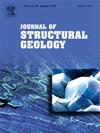Late Quaternary tectonics of the Jiujing-Bantan fault along the southern Beishan Block and its implication for the northward growth of the Tibetan Plateau
IF 2.9
2区 地球科学
Q2 GEOSCIENCES, MULTIDISCIPLINARY
引用次数: 0
Abstract
In the northern Tibetan Plateau, a series of northeast-striking faults have developed within the Xijianquan-Jiujing transtensional fault system (XJTFS), located approximately 150 km north of the Altyn Tagh Fault along the southern Beishan Block. Among these, the easternmost Jiujing-Bantan Fault (JBF) is the most active. Field mapping, unmanned aerial vehicle-derived digital topography, Google Earth imagery, and audio-magnetotelluric profiles reveal that the JBF, approximately 28 km in length, comprises four linear branches forming a negative flower structure. Displacement of landforms, such as terminal facets, terraces, small gullies, and ridges, indicates that the fault exhibits left-lateral strike-slip movement with a normal component. The vertical slip rate has been estimated at ∼0.02 mm/yr since ∼125 ka BP. Trenching research along the JBF identified four paleoseismic events, dated using optically stimulated luminescence (OSL) to approximately 20, 27–31, 34, and 76–78 ka BP. The potential seismic magnitude along the fault is estimated at M 6.3– 6.5. These findings, combined with regional geodetic data, suggest that late Quaternary deformation in the northern Tibetan Plateau has propagated into the southern Beishan Block. This deformation is inferred to be influenced by the clockwise transpressional deformation and northeastward movement of the Tashi micro-Block, located north of the Altyn Tagh Fault. The observed deformation pattern demonstrates strain partitioning and transfer between the northern Tibetan Plateau and the southern Mongolian Plateau.
北山地块南段九井-半潭断裂晚第四纪构造及其对青藏高原向北发育的启示
在青藏高原北部,沿北山地块南侧阿尔金断裂带以北约150 km的西剑泉—九井张拉断裂体系(XJTFS)内发育一系列东北向断裂。其中,最东端的九井—坂潭断裂最为活跃。野外测绘、无人机衍生的数字地形、谷歌地球图像和音频大地电磁剖面显示,JBF长约28公里,由四条线性分支组成,形成负花朵结构。末裂面、阶地、小沟壑和山脊等地貌的位移表明,该断层表现为左侧走滑运动,并具有正向分量。自~ 125 ka BP以来,垂直滑移率估计为~ 0.02 mm/yr。沿着JBF的沟槽研究确定了四个古地震事件,使用光学激发发光(OSL)确定了大约20、27-31、34和76-78 ka BP。沿断层的潜在地震震级估计为6.3 - 6.5级。这些发现与区域大地测量资料相结合,表明青藏高原北部晚第四纪变形已扩散到北山地块南部。推断该变形受阿尔金断裂带以北扎西微地块顺时针逆挤压变形和向东北运动的影响。观测到的变形模式显示青藏高原北部和蒙古高原南部之间的应变分配和转移。
本文章由计算机程序翻译,如有差异,请以英文原文为准。
求助全文
约1分钟内获得全文
求助全文
来源期刊

Journal of Structural Geology
地学-地球科学综合
CiteScore
6.00
自引率
19.40%
发文量
192
审稿时长
15.7 weeks
期刊介绍:
The Journal of Structural Geology publishes process-oriented investigations about structural geology using appropriate combinations of analog and digital field data, seismic reflection data, satellite-derived data, geometric analysis, kinematic analysis, laboratory experiments, computer visualizations, and analogue or numerical modelling on all scales. Contributions are encouraged to draw perspectives from rheology, rock mechanics, geophysics,metamorphism, sedimentology, petroleum geology, economic geology, geodynamics, planetary geology, tectonics and neotectonics to provide a more powerful understanding of deformation processes and systems. Given the visual nature of the discipline, supplementary materials that portray the data and analysis in 3-D or quasi 3-D manners, including the use of videos, and/or graphical abstracts can significantly strengthen the impact of contributions.
 求助内容:
求助内容: 应助结果提醒方式:
应助结果提醒方式:


